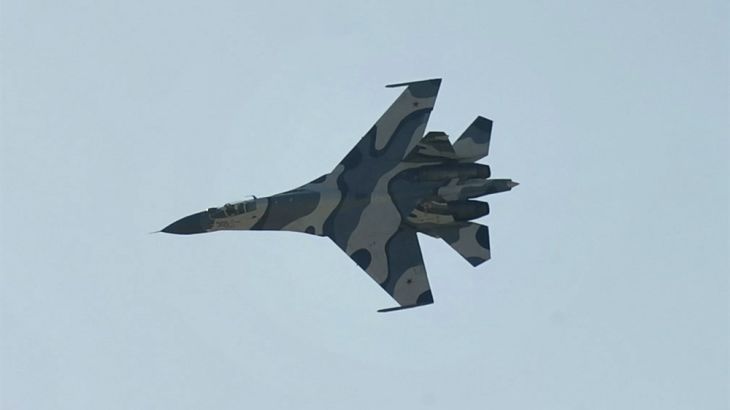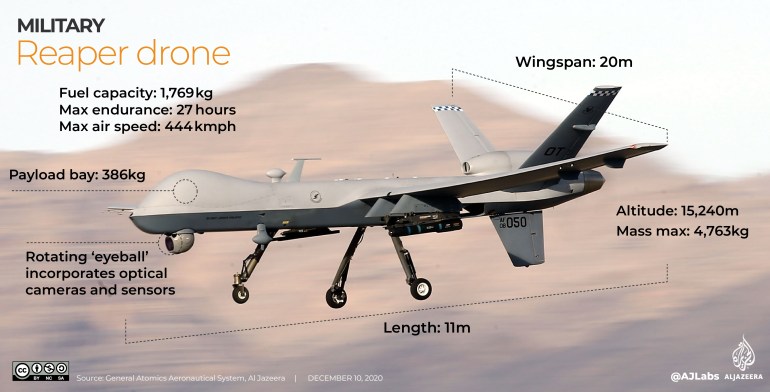US accuses Russia of downing drone over Black Sea: What we know
US and Russia give conflicting accounts of events that led a multimillion-dollar drone to crash into the Black Sea.

Washington’s claim that a Russian fighter jet collided with a US surveillance drone near Crimea causing it to crash is both a rare military incident between the two superpowers and a serious escalation in already tense relations since Moscow’s invasion of Ukraine last year.
US and Russian officials have given conflicting accounts of what occurred on Tuesday over the Black Sea between the MQ-9 Reaper drone, valued at more than $30m and packed with sensitive US spying technology, and two Russian Su-27 fighter jets that were deployed to intercept the US aircraft.
Keep reading
list of 4 itemsRussia unnerved by drone attacks blamed on Ukraine
Drones and the Future of War
Putin orders tightening of Ukraine border as drones hit Russia
Here is what we know about the incident so far:
What the US said happened
The Pentagon said the two Russian Su-27 aircraft intercepted the drone and proceeded to dump fuel on the MQ-9 Reaper model as it conducted routine surveillance over the Black Sea in international airspace.
US officials said the Russian jets flew around and in front of the drone several times for 30 to 40 minutes, and then one of the Su-27 fighters “struck the propeller” of the drone, “causing US forces to have to bring the MQ-9 down in international waters”.
A Pentagon spokesman said the collision likely damaged the Russian fighter jet, though the Su-27 did land.
It is not clear if the collision was an accident or intentional on the part of the Russian pilots, but both sides align in reporting that Russian aircraft had intercepted the drone.
US officials said the drone was operating in international airspace, reportedly west of Crimea over the Black Sea.

Russia’s position
The Russian defence ministry said the drone was flying near Russia’s border and intruded into an area that was declared off limits by Russian authorities.
Fighter jets were scrambled to intercept the drone, which the Russian ambassador to the US claimed had its transponders turned off – a piece of equipment that allows an aircraft to be identified in the air.
The defence ministry said the two fighter jets did not use their on-board weapons against the US drone and did not come into physical contact with the aircraft. The drone crashed for its own reasons, the ministry said.
“As a result of quick manoeuvring, MQ9 went into unguided flight with loss of altitude & collided with the water surface,” the Russian Embassy in Washington, DC said in a tweet citing the ministry.
⚡️@mod_russia: 🇷🇺 fighter jets scrambled to identify the intruder. As a result of quick manoeuvring MQ-9 went into an unguided flight with a loss of altitude & collided with the water surface.
❗️The 🇷🇺 aircraft didn't use on-board weapons, didn't come into contact with MQ-9. pic.twitter.com/1IMi3X0D0i
— Russian Embassy in USA 🇷🇺 (@RusEmbUSA) March 14, 2023
“MQ-9 drone flew with its transponders off, violating the boundaries of the temporary airspace regime established for the special military operation, communicated to all users of international airspace, and published in accordance with international standards,” the embassy said.
Russia has declared broad areas near Crimea off limits to flights. The US does not recognise Russia’s annexation of Crimea following the invasion of the territory in 2014.
Russia’s Ambassador to the US Anatoly Antonov said the US drone had gathered intelligence that was then used by Ukrainian forces to attack Russia.
“We are well aware of the missions such reconnaissance and strike drones are used for,” the ambassador said on his Telegram channel on Wednesday. US drone flights in the region gather intelligence “which is later used by the Kiev regime to attack our armed forces and territory”, he said.
Diplomatic fallout
The US State Department summoned Ambassador Antonov to a meeting with Karen Donfried, the assistant secretary of state for Europe.
US State Department spokesman Ned Price said: “We are engaging directly with the Russians, again at senior levels, to convey our strong objections to this unsafe, unprofessional intercept, which caused the downing of the unmanned US aircraft.”
US Defense Secretary Lloyd Austin has not spoken with his Russian counterpart regarding the incident, Ryder said.
NEWS: Russian Fighter Strikes U.S. Unmanned Aircraft https://t.co/3eDx3LYW6v
— Department of Defense 🇺🇸 (@DeptofDefense) March 14, 2023
Al Jazeera’s Mike Hanna, reporting from Washington, DC, said the drone incident was “potentially very serious” as it took place amid escalating tensions between Russia and the US over the invasion of Ukraine.
“Any incident like this, with the situation as tenuous as it is, is a problem for both sides,” he said.
“But what we are seeing here is an attempt perhaps by both sides not to allow the situation to escalate further,” he added.